Regions
Southern Adamello, Adamello - Presanella, Northern Brenta - Peller, Southern Brenta, Sole, Pejo and Rabbi, Ortler Range, Maddalene, Ulten Valley
AM
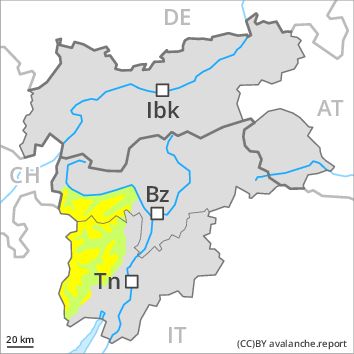
Danger level
Danger Level 2 - Moderate above 2400m
Danger Level 1 - Low above 2400m
Avalanche Problem
Wind-drifted snow above 2400m, N-NE-E-NW
PM

Danger level
Danger Level 2 - Moderate above 2400m
Danger Level 2 - Moderate above 2400m
Avalanche Problem
Wet snow above 2600m, SE-S-SW-W
Wind-drifted snow above 2400m, N-NE-E-NW
Wind slabs require caution. The danger of wet avalanches will increase during the day.
The Avalanche Warning Service currently has only a small amount of information that has been collected in the field, so that the avalanche danger should be investigated especially thoroughly in the relevant locality.
As a consequence of a sometimes moderate southwesterly wind, small wind slabs formed in the last few days. This applies in particular adjacent to ridgelines and in gullies and bowls. Mostly the avalanches are rather small but in some cases easily released.
As a consequence of warming during the day and the solar radiation, the likelihood of moist and wet avalanches being released will increase gradually. Transportation routes situated at higher altitudes and exposed parts of transportation routes are endangered in some cases especially at intermediate and high altitudes.
Snowpack
dp 10: springtime scenario
dp 6: cold, loose snow and wind
Outgoing longwave radiation during the night will be quite good over a wide area. The surface of the snowpack will freeze to form a strong crust and will soften earlier than the day before. At intermediate altitudes the snow is wet. Individual weak layers exist in the old snowpack. At low altitude no snow is lying.
Tendency
Increase in danger of wet avalanches as a consequence of warming during the day and solar radiation.
Regions
Eastern Deferegger Alps, Schober Mountains, Lienzer Dolomites
AM
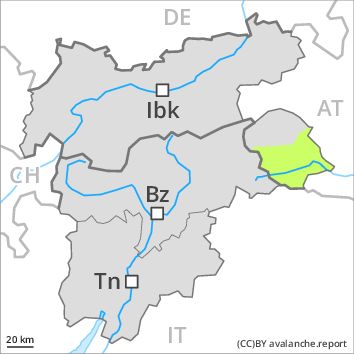
Danger level
Danger Level 1 - Low above 2200m
Danger Level 1 - Low above 2200m
Avalanche Problem
Wind-drifted snow above 2200m, N-NE-E-W-NW
PM

Danger level
Danger Level 2 - Moderate above 2200m
Danger Level 2 - Moderate above 2200m
Avalanche Problem
Wind-drifted snow above 2200m, N-NE-E-W-NW
Wet snow above the treeline, E-SE-S-SW-W
Wet and gliding avalanches are to be expected from around the middle of the day. Wind slabs are in some cases prone to triggering above the tree line.
In the last few days mostly small wind slabs formed in particular adjacent to ridgelines. These are in isolated cases prone to triggering, especially on very steep shady slopes above the tree line adjacent to ridgelines.
These avalanche prone locations are very rare and are clearly recognisable to the trained eye. The avalanches are rather small but in some cases easily released.
Snowpack
dp 10: springtime scenario
dp 6: cold, loose snow and wind
At low altitude no snow is lying. At intermediate altitudes the snow is wet. The somewhat older wind slabs have bonded well with the old snowpack in all aspects. Old wind slabs require caution.
Tendency
Slight increase in avalanche danger as a consequence of warming during the day and solar radiation.
Regions
Karwendel Mountains, Brandenberg Alps, Western Kitzbühel Alps, Wilder Kaiser Mountains - Waidring Alps, Eastern Kitzbühel Alps
AM
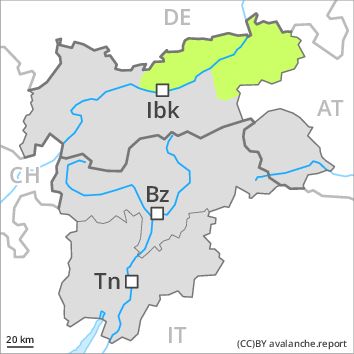
Danger level
Danger Level 1 - Low above 1800m
Danger Level 1 - Low above 1800m
Avalanche Problem
Wind-drifted snow above 2400m, N-NE-E-W-NW
PM

Danger level
Danger Level 2 - Moderate above 1800m
Danger Level 2 - Moderate above 1800m
Avalanche Problem
Wind-drifted snow above 2400m, N-NE-E-W-NW
Wet snow above 2400m, E-SE-S-SW-W
Wind slabs are in some cases prone to triggering above the tree line. Wet and gliding avalanches are to be expected from around the middle of the day.
In the last few days rather small wind slabs formed in particular adjacent to ridgelines. These are in isolated cases prone to triggering. Caution is to be exercised in particular adjacent to ridgelines and in gullies and bowls. These avalanche prone locations are rather rare and are clearly recognisable to the trained eye. Mostly the avalanches are rather small.
Snowpack
dp 6: cold, loose snow and wind
dp 10: springtime scenario
At low altitude no snow is lying. At intermediate altitudes the snow is wet. Outgoing longwave radiation during the night will be quite good. The fresh and somewhat older wind slabs have bonded well with the old snowpack in all aspects.
Tendency
Slight increase in avalanche danger as a consequence of warming during the day and solar radiation.
Regions
Sexten Dolomites, Eastern Pfunderer Mountains, Durreck Range, Western Rieserferner Mountains, Val Müstair Alps, Western Deferegger Alps, Langtaufers, Schnals Ridge, Southern Stubai Alps, Southern Zillertal Alps and High Tauern, Eastern Nonsberger Alps, Northern Dolomites of Fiemme, Saldurn-Mastaun Ridge, Gröden Dolomites, Texel Mountains, Prags Dolomites, Sarntal Alps, Western Pfunderer Mountains
AM
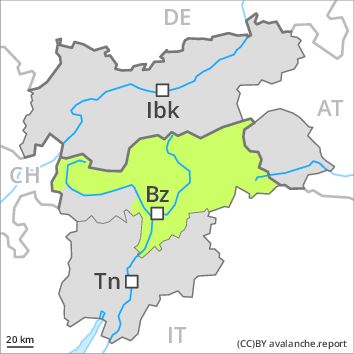
Danger level
Danger Level 1 - Low
Avalanche Problem
Wind-drifted snow above 2400m, N-NE-NW
PM

Danger level
Danger Level 2 - Moderate
Avalanche Problem
Wet snow above 2600m, E-SE-S-SW-W
Wind-drifted snow above 2400m, N-NE-NW
A favourable early-morning avalanche situation will prevail. The danger of wet avalanches will increase during the day.
The Avalanche Warning Service currently has only a small amount of information that has been collected in the field, so that the avalanche danger should be investigated especially thoroughly in the relevant locality.
As a consequence of a sometimes moderate southwesterly wind, mostly small wind slabs formed in the last few days. These are in some cases still prone to triggering at high altitudes and in high Alpine regions, in particular adjacent to ridgelines and in gullies and bowls. Mostly the avalanches are rather small but in some cases easily released.
As a consequence of warming during the day and the solar radiation, the likelihood of moist and wet avalanches being released will increase gradually. Transportation routes situated at higher altitudes and exposed parts of transportation routes are endangered in some cases especially at intermediate and high altitudes.
Snowpack
Outgoing longwave radiation during the night will be quite good over a wide area. The surface of the snowpack will freeze to form a strong crust and will soften earlier than the day before. At intermediate altitudes the snow is wet. Individual weak layers exist in the old snowpack. At low altitude no snow is lying.
Tendency
Increase in danger of wet avalanches as a consequence of warming during the day and solar radiation.
Regions
Weißkugel Range, Western Verwall Mountains, Gurgler Range, Central Stubai Alps, Eastern Verwall Mountains, Northern Zillertal Alps, Allgäu Alps, Silvretta, Venediger Range, Samnaun Mountains, Eastern Lechtal Alps - Ammergau Alps, Northern Oetz and Stubai Alps, Mieming Mountains, Eastern Rieserferner Mountains, Western Tuxer Alps, Glockner Range, Eastern Tuxer Alps, Western Lechtal Alps, Central Lechtal Alps, Glockturm Range, Grieskogel Mountains
AM
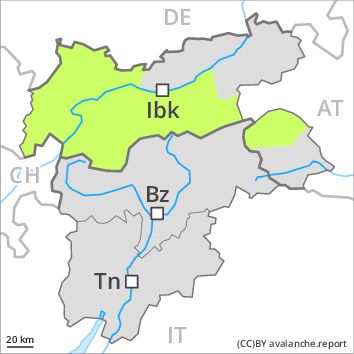
Danger level
Danger Level 1 - Low above 2400m
Danger Level 1 - Low above 2400m
Avalanche Problem
Wind-drifted snow above the treeline, N-NE-E-W-NW
PM

Danger level
Danger Level 2 - Moderate above 2400m
Danger Level 2 - Moderate above 2400m
Avalanche Problem
Wind-drifted snow above 2400m, N-NE-E-W-NW
Wet snow above 2600m, E-SE-S-SW-W
Wet and gliding avalanches are to be expected from around the middle of the day. Wind slabs are in individual cases still prone to triggering at high altitudes and in high Alpine regions.
In the last few days rather small wind slabs formed in particular adjacent to ridgelines. These are in some cases prone to triggering, especially adjacent to ridgelines and in gullies and bowls. Mostly the avalanches are rather small but in some cases easily released.
In addition the no longer entirely fresh wind slabs should be taken into account. These are in individual cases still prone to triggering. These avalanche prone locations are rather rare and are clearly recognisable to the trained eye.
Snowpack
dp 10: springtime scenario
dp 6: cold, loose snow and wind
At low altitude no snow is lying. At intermediate altitudes the snow is wet. Outgoing longwave radiation during the night will be good. The fresh and somewhat older wind slabs have bonded well with the old snowpack in all aspects below approximately 2600 m.
In some places wind slabs are lying on soft layers. In very isolated cases weak layers exist in the old snowpack in particular on northwest, north and northeast facing slopes, especially above approximately 2600 m.
Tendency
Slight increase in avalanche danger as a consequence of warming during the day and solar radiation.
Regions
Latemar, Primiero - Pale di S. Martino, Prealps, Cembra Valley, Bondone and Stivo, Vallarsa, Western Nonsberg Alps, Folgaria - Laverone, Fassa Valley, Southern Lagorai, Ledro Valley, Northern Lagorai, Paganella, Marzola - Valsugana, Pine' - Mocheni Valley
AM

Danger level
Danger Level 1 - Low
Avalanche Problem
Wind-drifted snow above 2400m, N-NE-NW
PM
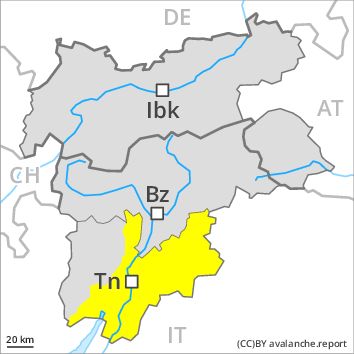
Danger level
Danger Level 2 - Moderate
Avalanche Problem
Wet snow above 2600m, E-SE-S-SW-W
Wind-drifted snow above 2400m, N-NE-NW
A favourable early-morning avalanche situation will prevail. The danger of wet avalanches will increase during the day.
The Avalanche Warning Service currently has only a small amount of information about the snowpack, so that the avalanche danger should be investigated especially thoroughly in the relevant locality.
As a consequence of a sometimes moderate southwesterly wind, mostly small wind slabs formed in the last few days. The avalanches are small.
As a consequence of warming during the day and the solar radiation, the likelihood of moist and wet avalanches being released will increase gradually. Transportation routes situated at higher altitudes and exposed parts of transportation routes are endangered in some cases especially at intermediate and high altitudes.
Snowpack
Outgoing longwave radiation during the night will be quite good over a wide area. The surface of the snowpack will freeze to form a strong crust and will soften earlier than the day before. At intermediate altitudes the snow is wet. Individual weak layers exist in the old snowpack. At low altitude no snow is lying.
Tendency
Increase in danger of wet avalanches as a consequence of warming during the day and solar radiation.











